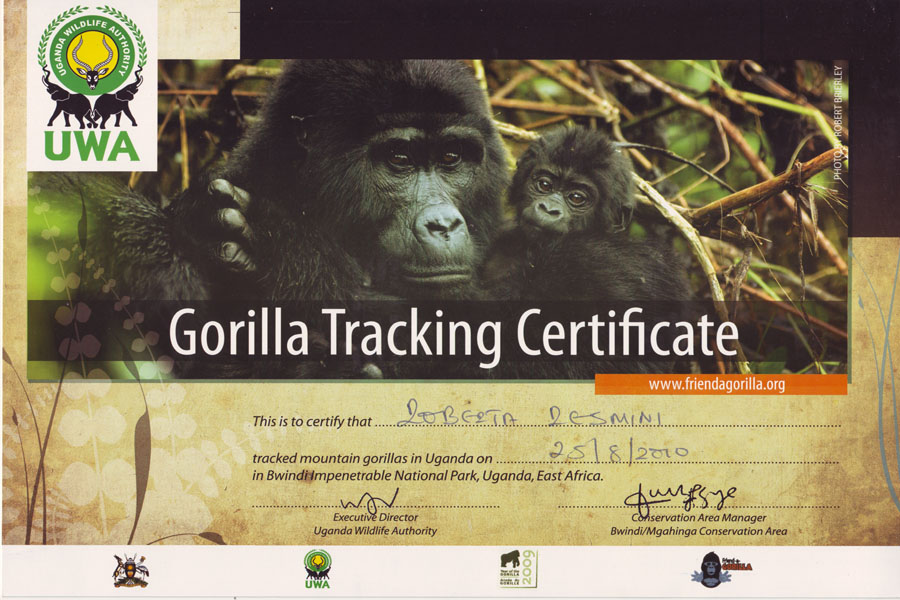Facts About Zebras Facts about zebras in Africa (Uganda and Rwanda). Zebras are among the…

Gorilla Trekking Certificates
Gorilla Trekking Certificates (Best Gorilla Trip, Cost) -Uganda Safaris
What is a gorilla trekking certificate?
Gorilla Trekking Certificates -What is a gorilla trekking certificate? A gorilla trekking certificate is a valid document the park authorities (Uganda Wildlife Authority -UWA) provides visitors upon returning from their successful trek with endangered mountain gorillas. The gorilla certificates are only availed to trekkers who complete the trek with mountain gorillas.

Where to go for gorilla trekking?
Meeting face to face with the endangered mountain gorillas in their natural habitat is only possible in the Virunga National Park in the Democratic Republic of Congo, Volcanoes National Park in Rwanda, and Bwindi Impenetrable and Mgahinga Gorilla National Park in Uganda is a dream-come-true for many primate lovers. There is no doubt that these three countries are the must-visit places for visitors who wish to see gorillas.
Occupying the dense forests between 2500 and 4000 meters above sea level, mountain gorillas roam freely in their natural habitats and each gorilla family occupies a unique home range. While gorilla trekking adventures are offered in three countries, Uganda and Rwanda are the safer and more stress-free places to enjoy the excitement and unforgettable experiences of getting up close and personal with the Giant Apes in their natural habitats.
With the high elevation and dense vegetation in mountain gorilla natural habitats, making treks/hikes to the allocated gorilla family is usually challenging- mentally and physically (long and arduous, lasting from two to six hours).
Many travelers give up halfway during the gorilla treks and those who finally make it to the mountain gorillas and return back to the Park Headquarters/briefing point are awarded with gorilla trekking certificates for their courageous deeds.
What level of fitness is needed for gorilla trekking in Uganda or Rwanda?
Generally, moderate level of physical fitness is required for you to have a successful mountain gorilla trek in Uganda/Rwanda. Trekking the mountain gorillas seems difficult-to-achieve for some travelers, and the great requirement is your physical quality, besides securing a valid gorilla trekking permit.
For many travelers, taking the hike to meet the mountain gorillas in their natural habitats is physically and mentally challenging but the reward of finally meeting face-to-face with the silverback playing with infants, adult females nursing their babies, infants playing and jumping on tree branches, and other members of the gorilla family resting after a long and arduous walk leaves memories that last a lifetime.
Whether you are a first-timer or repeat trekker, gorilla trekking is generally challenging and undeniably a wonderful achievement. The Gorilla Trekking certificate (a document) means that you have achieved the rare opportunity of meeting face to face with the Giant Apes that most travelers don’t get to achieve.
How much does a gorilla trekking permit cost?
A gorilla trekking permit in Uganda valid 2024-2026 costs $ 800 per person -for the foreign nonresidents. The foreign residents can obtain their permits at USD 700 per person. Ugandans plus other citizens within East Africa Community (EAC) pay UGX 300,000 per person. The newly introduced package that is for the Rest of Africa (ROA) pay USD 500 per person.
A Uganda gorilla permit can be obtained through a reliable tour operator Maranatha Tours and Travel. Talk to Us via info@adventureugandasafaris.com.
What you need to pack for Gorilla Trekking safaris
Your typical gorilla trekking packing list should include sturdy trekking/hiking boots for maneuvering through the steep slopes and slippery/muddy forest trails, a waterproof rain jacket as rains are sometimes common during trekking, long cotton socks, comfortable and breathable long trousers to cover your legs from scratching or stinging nettles while trekking.
Other items to pack include long-sleeved shirt/s to cover the legs from scratching, a pair/s of binoculars for spotting small and far creatures such as birds while trekking, a non-flash camera with extra batteries and memory space to capture the special moments during gorilla trekking.
A sun hat for protecting your head and eyes from sunshine, sunglasses, a waterproof backpack for storing items (such as camera, snacks, drinking water, binoculars, and others) needed while trekking, a first aid kit, and toiletries (especially deodorants, toothpaste and toothbrush, sunscreen, period supplies for female travelers, hair combs/brush, and others).
The best months to go gorilla tracking
The best months for primate lovers to go gorilla trekking are from June to September and December to February because temperatures are warmer and rainfall levels are lower. This means forest trails are also drier and less muddy/slippery hence making it less challenging to walk through the forest.
During the months of March, April, May, October, and November, rainfall levels increase, making forest trails to be muddy and slippery hence challenging to use while trekking the mountain gorillas. However, flowers are in bloom and the skies are cleared of any dust thus providing best photography opportunities.
Nonetheless, weather on the mountains and forests (typically mountain gorilla habitats) is quite hard to predict hence we always advise visitors to be prepared for anything- heavy rains or hot sunshine regardless of the season.
How much do I tip a gorilla trek guide?
No exact amount is required for you to tip a guide or anyone who provides you a service. The amount you want to tip usually comes out of will. Often, guests tip from USD 10 or even USD 100. It generally depends on one’s heart.
Is gorilla trekking worth the money?
Yes! 100% worth every penny and efforts. What you pay for gorilla tours or gorilla trekking is largely used to facilitate gorilla conservation efforts.
How do I go for gorilla trekking?
Book a gorilla tour to any of destinations you desire to trek mountain gorillas from. It can be Bwindi National Park, Mgahinga, or Volcanoes National Park in Rwanda.
